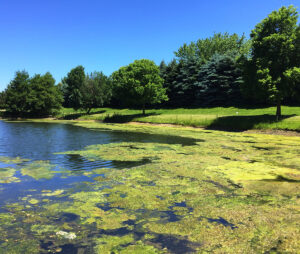
Harmful algal blooms (HABs) can present dangers to pets, which is why owners should be mindful of them when temperatures begin to rise.
Harmful algal blooms (HABs) have become a growing environmental and public health concern, affecting not only human populations but also the animals we love. These blooms, caused by the rapid growth of toxin-producing microalgae, can be found in both freshwater and marine environments. For pet owners, the presence of HABs in local water bodies is something that must be taken seriously, as the toxins released by these blooms can pose severe and even fatal risks to pets.
What Are Harmful Algal Blooms (HABs)?
Harmful algal blooms occur when certain types of microalgae, such as cyanobacteria (commonly known as blue-green algae) and other species of dinoflagellates and diatoms, grow excessively in water. While algae are a natural part of aquatic ecosystems, specific environmental conditions—such as warm water temperatures and an abundance of nutrients like phosphorus and nitrogen—can trigger explosive growth, leading to the formation of HABs. These blooms can produce a variety of toxins that are hazardous to all living organisms, including pets.
How HABs Can Harm Pets
Pets, particularly dogs, are at high risk of exposure to HABs because of their tendency to play in, drink from, or explore bodies of water. Even a brief encounter with contaminated water can have dire consequences. Depending on the type of toxin and the level of exposure, pets can suffer from a range of symptoms, from mild irritation to life-threatening conditions.
Cyanobacteria and Freshwater HABs
Cyanobacteria are one of the most common culprits behind freshwater HABs. These microorganisms can produce several potent toxins that can cause severe health issues in pets. The three main types of cyanobacterial toxins are hepatotoxins, neurotoxins, and dermatotoxins, each affecting the body in different ways.
- Hepatotoxins: Toxins like microcystins, nodularins, and cylindrospermopsin target the liver, leading to symptoms such as vomiting, diarrhea, loss of appetite, lethargy, and jaundice. In severe cases, these toxins can cause liver failure, which may result in death if not treated promptly.
- Neurotoxins: Toxins such as anatoxins and saxitoxins interfere with nerve cell communication. Neurotoxins can cause symptoms including muscle tremors, paralysis, and difficulty breathing. In extreme cases, exposure to these toxins can lead to respiratory failure and death within minutes to hours.
- Dermatotoxins: Toxins like aplysiatoxin and lyngbyatoxin-a can cause skin irritation and respiratory issues if inhaled or if the skin comes into contact with contaminated water. Pets may experience itching, redness, and discomfort, as well as coughing and wheezing.
Marine HABs and Red Tides
Marine environments are also susceptible to harmful algal blooms, often referred to as “red tides,” although these blooms can vary in color. Marine HABs are caused by species like dinoflagellates and diatoms and can produce toxins that accumulate in seafood, posing a risk to both humans and animals.
Toxins associated with marine HABs include:
- Brevetoxins: These can cause Neurotoxic Shellfish Poisoning (NSP) and may lead to symptoms such as vomiting, diarrhea, and neurological issues in pets.
- Saxitoxins: Responsible for Paralytic Shellfish Poisoning (PSP), these toxins can cause paralysis and respiratory failure.
- Domoic Acid: Known for causing Amnesic Shellfish Poisoning (ASP), domoic acid can lead to seizures and permanent brain damage in severe cases.
Recognizing the Signs of HAB Exposure in Pets
Pet owners should be vigilant about recognizing the signs of HAB exposure, especially if their pets have recently been near or in water. Symptoms to watch for include:
- Vomiting and diarrhea
- Excessive drooling
- Difficulty breathing
- Weakness or paralysis
- Seizures or tremors
- Skin irritation or redness
If you suspect your pet has been exposed to contaminated water, it is crucial to seek veterinary care immediately. The sooner treatment is administered, the better the chances of recovery.
Preventing HAB Exposure
Preventing exposure to HABs is the best way to keep pets safe. Here are some tips for pet owners:
- Avoid Stagnant Water: Refrain from letting your pet swim in or drink from stagnant water, especially during warm weather when HABs are more likely to occur.
- Check for Warnings: Many local authorities monitor water bodies for HABs and issue warnings if blooms are detected. Always check for advisories before allowing your pet to swim in natural bodies of water.
- Rinse After Swimming: If your pet has been swimming in natural water, rinse them off with clean water immediately to remove any potential contaminants.
- Keep Pets Leashed Near Water: When walking near lakes, rivers, or the ocean, keep your pet leashed to prevent them from running into contaminated water.
Trust Maryland Veterinary Surgical Services With Your Companion’s Health
Your companion’s health is important, and the team at MVSS is ready to provide the best care possible for your furry family. We are dedicated to combining comprehensive exams and assessments with informative and honest discussions of your companion’s care. Once we have worked with you to decide on the best course of action for your dog, our professionals will use their surgical expertise to work towards the goal of giving your companion an active and pain-free life. We are proud to serve loyal companions in Catonsville and Baltimore. To learn more about our services, give us a call at 410-788-4088 or visit us online. For more information and tips for dog health, follow us on Facebook and Pinterest.
